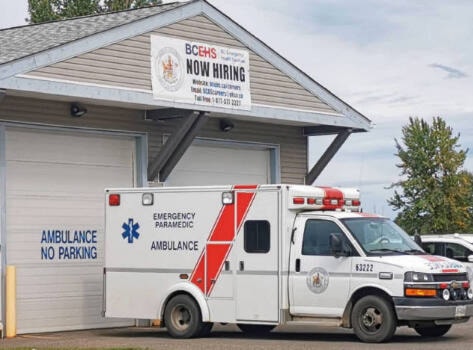The president of the union representing paramedics and medical dispatchers is crediting provincial health minister Adrian Dix for agreeing to convert 24 ambulance stations in more rural and remote areas of the province, including the ones in Houston and in Burns Lake, to 24/7 service from part time coverage.
“It’s the biggest change I’ve seen in my 33 years in the ambulance service at once,” says Troy Clifford of the Canadian Union of Public Employees Local 873 which represents nearly 5,000 paramedics and medical dispatchers.
The union had been pressing the provincial government for years for more paramedics and dispatchers and better pay and career positions to recruit and retain people.
Some progress had been made through the introduction of a scheduled on call system (SOC) in which paramedics are paid to be at a station for an eight-hour shift and then 16 hours at home over a three-day shift period.
It was given a trial introduction in several places on Vancouver Island and found wanting in some aspects, causing the union to push forward again for pay and position changes.
Then in late June and into July the arrival of the heat dome, increasing temperatures dramatically around the province with the greatest effects being felt in the Lower Mainland, almost buckled the ambulance service.
Calls for service took hours if at all and there weren’t enough crews to handle the volume.
“We had been asking for changes for years, a very long time. But it was the heat dome where things came to a head,” said Clifford.
“Our members were psychologically done, at a very low point. I felt, they all felt, hopeless,” he said of staffing and service shortages and the demands of long hours and call volumes.
Clifford then went to senior health officials and to Dix, a person with whom he was familiar thanks to previous lobbying efforts.
“They stepped up. I’ve got to give credit where credit is due. Dix is really committed to the ambulance service. He went to bat for us. He got the money,” Clifford added.
The result is the creation of eight full time positions in each of 24 communities, sufficient to provide two paramedics at the stations, 24 hours a day, seven days a week.
One of the problems with the SOC scheduling, Clifford explained, is that although paramedics were at the station for eight hours at a time, they were on-call the remaining 16 hours in a day.
“The response to the citizens and to the communities can now be immediate,” he said.
Under the CUPE collective agreement, four of the full time positions at each station are to be filled with paramedics from other locations and four from paramedics already working on-call at the station.
And having full time positions creates a viable model for recruiting, retention and stability, especially when there is a high demand for trained emergency responders from the private sector, said Clifford.
Still, there are challenges that await, particularly in finding enough people to fill the full time positions.
One of those challenges is that paramedics who are not full time and are on call instead are paid $2 an hour.
“That’s a barrier,” said Clifford in that it dissuades people from considering a career with the ambulance service from the outset.
“The back up positions, the fill ins. That’s what we need to work on right now.”
If all goes according to plan, the first of the 24 stations will convert to 24/7 service by the end of October.
Houston and Burns Lake also have community paramedics who make house calls to provide basic care and thus seek to prevent an emergency from occurring that requires a 911 call. These positions won’t be affected by the 24/7 coverage.
Houston and Burns Lake are two of six stations in the north to convert to 24/7 coverage. The other locations are Chetwynd, Fort St James, Fort Nelson and Vanderhoof.
